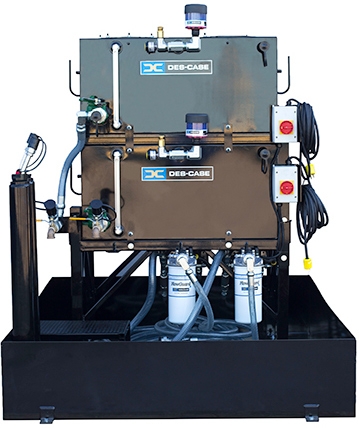Have you considered the correlation between how well you manage your lubrication program and safety? On the surface, the two may not appear to have anything to do with one another, but they are linked in more ways than you might think. Almost no work environment is as hazardous as manufacturing and most dangers are directly related to the performance of your equipment. Slipping, chemical exposure, machinery interaction, fire, and tripping are just some of the more common safety hazards you can avoid through better lubrication practices. In this post, we will break down how optimizing your lubrication program decreases each one of these risks.
STORING AND CONTAINING THE LUBRICANT (Slipping and Fire)When storing bulk fluids you want to make sure you have appropriate spill containment. There will likely be regulations - both federal and U.S. state regulations that will dictate what type of spill containment you use. Typically, it is equal to the volume of fluid stored in any given tank to minimize any spills during storage.
Safety and environmental practices goes beyond storage spill containment. If you look at the oil in the asset itself, in some industries, you will see a lot of leaking. In plants, slip and fire hazards can occur from oil leaking from assets. From the perspective of walking through the plant, you want to be mindful of any leakage and if you do have any leakage or spills to clean it up quickly and efficiently, while scheduling appropriate maintenance to address the root cause. Additionally, sparks from nearby welding could ignite the lubricant causing a fire.
PICKING THE RIGHT LUBRICANT AND PROTECTION (Chemical Exposure)Most mineral-based fluids are fairly benign. That is not to say they are completely safe, but if you were to get a little bit of mineral-based lubricant on your bare skin it would not necessarily cause you a lot of problems. However, there are lubricants that can be potentially hazardous, particularly some greases. Certain fluids, phosphate esters for example, are very aggressive when handled – you should not handle them with bare skin.
Allergic reactions to certain lubricants can also be a concern. Some employees may have a reaction every time their skin touches certain lubricants regardless of whether those lubricants are considered hazardous to touch.
In all instances, when lubricant exposure is possible it is important to wear the proper protective equipment: hand protection, eye and face protection, and protective footwear.
WORKING AROUND LUBRICANTS (Machinery Interaction)Every time you are re-greasing a bearing, visually inspecting a machine, taking an oil sample, or repairing equipment due to a lubrication-related failure, the physical act of interacting with the equipment is a hazard. There is always a potential for injury from falling, oxygen depletion in confined spaces, a machine unexpectedly starting, pinching, cutting, or tool malfunction. In fact, numerous studies have shown a direct correlation between equipment uptime and safety. Overall, it is going to create a better safety culture in the plant.
CLUTTER (Tripping)Clutter, unstable stacking, poor lighting, or lack of signage all contribute to thousands of injured workers every year. OSHA section 1910.22(a)(1) states, “All places of employment, passageways, storerooms, service rooms, and walking-working surfaces are kept in a clean, orderly, and sanitary condition.” This includes your lubricant storage spaces, which should be organized and ergonomic, with clear visual workplace management tools such as color coding, charts, and shadow boards used to denote what the desired state should be. Not maintaining these standards can also have a significant financial consequence with fines ranging from tens of thousands to hundreds of thousands of dollars.
SUMMING UPSafety is everyone’s responsibility. The best way to ensure safety measures are followed is awareness, training, proper signage, and re-enforcing the importance of safe work habits. Leakage control, storage organization, avoiding machine failure due to poor lubrication will go a long way to minimize the safety risks at your plant.
Talk to one of our experts today at
(855) 737-4717, or fill out our
online form to learn more.

